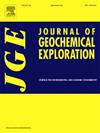Stream sediment and soil geochemistry of the largest volcanogenic massive sulfide deposit in Türkiye, Karaburun deposit (Central Pontides)
IF 3.3
2区 地球科学
Q1 GEOCHEMISTRY & GEOPHYSICS
引用次数: 0
Abstract
The recently discovered and potentially economic Karaburun deposit stands out as the largest VMS deposit in Türkiye, with a geological resource of ~125 Mt. at 1.16 wt% Cu, 0.25 wt% Zn, and 0.05 wt% Co. The pelitic-mafic type mineralization occurs within the low-grade greenschist facies metamorphic rocks in the Central Pontides Orogenic Belt. It is associated with volcaniclastic, clastic detrital sedimentary, and deep marine sedimentary rocks and cross-cutting submarine mafic dikes and/or sills. This study reports the statistical evaluation of stream sediment and soil geochemistry surveys, providing a well-documented example of preliminary surficial geochemical studies prior to the discovery of the Karaburun mineralization. Statistical analysis of 166 stream sediment samples shows that copper is the most reliable indicator of potential mineralization. Soil sampling was subsequently conducted in the source area of Cu anomalies, and a total of 2306 samples were collected. Both the median-median absolute deviation and the concentration-number (C![]() N) fractal methods yielded reliable results in determining spatial distributions; however, the fractal method provided more robust threshold values. The positive moderate to strong correlations between As–Pb–Zn and Cu–Zn–Bi indicate that these elements can be used to determine potential areas exhibiting anomalies. The distribution of selected elements in the “B” soil horizon is mostly consistent with the gossan formation. Anomalies in Cu, Zn and Co as the best indicator and pathfinder elements suggest weathering processes through pre-existent outcropping mineralized zones. The weathering, oxidation, and possibly erosion in the upper section of pre-existing Pb-enriched mineralization may have caused some Pb enrichments and local anomalies. Bismuth has been highlighted for the first time in soil geochemistry studies in the Central Pontides and could serve as a pathfinder element. However, structural features largely control the spatial distribution of elements and gossan zones; therefore, physical dispersion should also be considered alongside geochemical patterns. Factor analysis was applied to samples from Cu- and Zn-dominant zones identified through anomaly maps. The extracted factors collectively indicate associations with immobile elements during weathering processes, mineralization content, mafic volcanic or volcaniclastic rocks, and absorption onto Fe-oxides or newly formed compounds. Finally, we applied the robust weathering index, which indicates temperate climatic conditions during the weathering processes.
N) fractal methods yielded reliable results in determining spatial distributions; however, the fractal method provided more robust threshold values. The positive moderate to strong correlations between As–Pb–Zn and Cu–Zn–Bi indicate that these elements can be used to determine potential areas exhibiting anomalies. The distribution of selected elements in the “B” soil horizon is mostly consistent with the gossan formation. Anomalies in Cu, Zn and Co as the best indicator and pathfinder elements suggest weathering processes through pre-existent outcropping mineralized zones. The weathering, oxidation, and possibly erosion in the upper section of pre-existing Pb-enriched mineralization may have caused some Pb enrichments and local anomalies. Bismuth has been highlighted for the first time in soil geochemistry studies in the Central Pontides and could serve as a pathfinder element. However, structural features largely control the spatial distribution of elements and gossan zones; therefore, physical dispersion should also be considered alongside geochemical patterns. Factor analysis was applied to samples from Cu- and Zn-dominant zones identified through anomaly maps. The extracted factors collectively indicate associations with immobile elements during weathering processes, mineralization content, mafic volcanic or volcaniclastic rocks, and absorption onto Fe-oxides or newly formed compounds. Finally, we applied the robust weathering index, which indicates temperate climatic conditions during the weathering processes.
最近发现的具有潜在经济价值的卡拉布润(Karaburun)矿床是基ye地区最大的VMS矿床,地质资源约125 mt,含铜1.16 wt%,锌0.25% wt%,钴0.05% wt%。泥质-基性矿化发生在中央塘滩造山带低品位绿片岩相变质岩中。它与火山碎屑、碎屑沉积、深海海相沉积岩和海底基性岩脉和(或)基岩有关。本研究报告了水系沉积物和土壤地球化学调查的统计评价,提供了卡拉布润矿化发现之前初步地表地球化学研究的一个有充分文件证明的例子。对166个水系沉积物样品的统计分析表明,铜是潜在成矿作用最可靠的指标。随后在Cu异常源区进行土壤采样,共采集样品2306份。中位数-中位数绝对偏差法和浓度-数(CN)分形法在确定空间分布时结果可靠;然而,分形方法提供了更稳健的阈值。As-Pb-Zn和Cu-Zn-Bi之间的正相关性表明,这些元素可以用来确定异常的潜在区域。选择的元素在“B”层的分布与松质地层基本一致。Cu、Zn和Co异常作为最佳指示元素和探路者元素,表明风化过程经过了先存在的露头矿化带。先前富铅矿化上部的风化、氧化和可能的侵蚀作用可能导致了部分Pb富集和局部异常。铋在中央池塘土壤地球化学研究中首次得到重视,可以作为探路者元素。然而,构造特征在很大程度上控制了元素和松散带的空间分布;因此,除了地球化学模式外,还应考虑物理色散。对通过异常图确定的铜、锌优势带样品进行因子分析。提取的因子综合反映了与风化过程中的不动元素、矿化含量、基性火山或火山碎屑岩以及铁氧化物或新形成化合物的吸附有关。最后,应用鲁棒性风化指数,反映了风化过程中的温带气候条件。
本文章由计算机程序翻译,如有差异,请以英文原文为准。
求助全文
约1分钟内获得全文
求助全文
来源期刊

Journal of Geochemical Exploration
地学-地球化学与地球物理
CiteScore
7.40
自引率
7.70%
发文量
148
审稿时长
8.1 months
期刊介绍:
Journal of Geochemical Exploration is mostly dedicated to publication of original studies in exploration and environmental geochemistry and related topics.
Contributions considered of prevalent interest for the journal include researches based on the application of innovative methods to:
define the genesis and the evolution of mineral deposits including transfer of elements in large-scale mineralized areas.
analyze complex systems at the boundaries between bio-geochemistry, metal transport and mineral accumulation.
evaluate effects of historical mining activities on the surface environment.
trace pollutant sources and define their fate and transport models in the near-surface and surface environments involving solid, fluid and aerial matrices.
assess and quantify natural and technogenic radioactivity in the environment.
determine geochemical anomalies and set baseline reference values using compositional data analysis, multivariate statistics and geo-spatial analysis.
assess the impacts of anthropogenic contamination on ecosystems and human health at local and regional scale to prioritize and classify risks through deterministic and stochastic approaches.
Papers dedicated to the presentation of newly developed methods in analytical geochemistry to be applied in the field or in laboratory are also within the topics of interest for the journal.
 求助内容:
求助内容: 应助结果提醒方式:
应助结果提醒方式:


